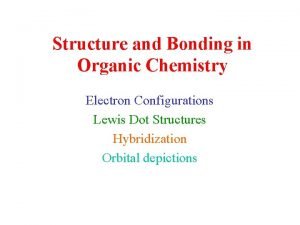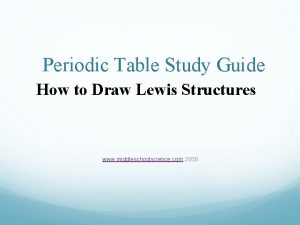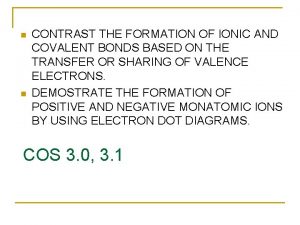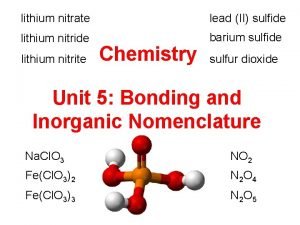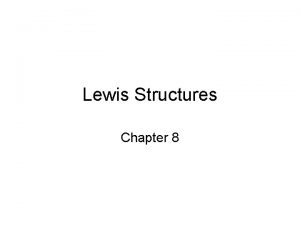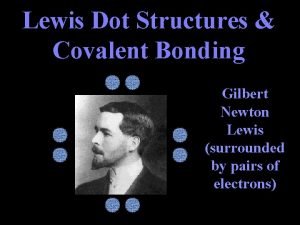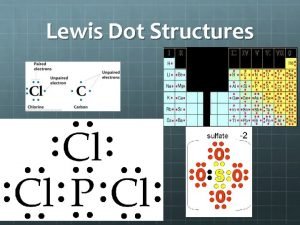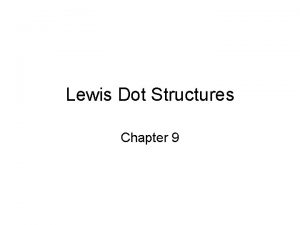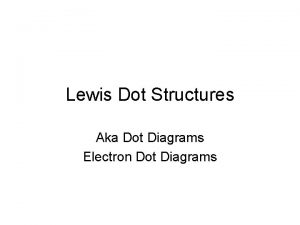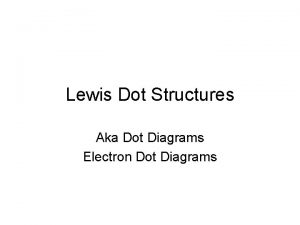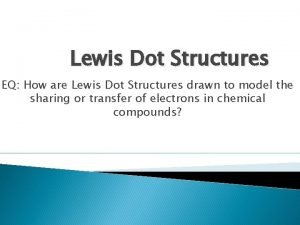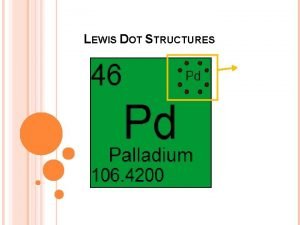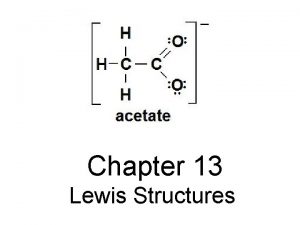Lewis Dot Structures AP Chemistry Unit 8 Lewis



















- Slides: 19

Lewis Dot Structures AP Chemistry Unit 8

Lewis Structures • Lewis structures are representations of molecules showing all electrons, bonding and nonbonding.

Dot Structures 1. Show valence electrons as dots. 2. Inner electrons and atomic nuclei are represented by the symbol for the element. O Mg Br N 3. Octet rule: 8 electrons in outermost energy level for elements in periods 2 -7. 4. Atoms that do not have an octet: H, Be, B

Writing Lewis Structures PCl 3 5 + 3(7) = 26 1. Find the sum of valence electrons of all atoms. The finished structure must have the same # of electrons.

Writing Lewis Structures 2. The central atom is the least electronegative element that isn’t hydrogen. Connect the outer atoms to it by single bonds. Make it symmetrical whenever possible. Place two e- in each bond. Keep track of the electrons: 26 6 = 20

Writing Lewis Structures 3. Fill the octets of the outer atoms, unless an exception. Keep counting the electrons: 26 6 = 20 18 = 2

Writing Lewis Structures 4. Place left over electrons on the central atom in pairs (lone pairs). Make sure you match the valence electrons and octets are complete.

Writing Lewis Structures 5. If you run out of electrons before the central atom has an octet… …form multiple bonds until it does.

Formal Charge • Usually more than one correct dot structure is possible. • Formal charge is a way to evaluate the best structure by closest formal charge = 0 • FC = valence e- in atom – valence e- in molecule CO 2 [lone pairs + ½ BP]

Resonance: when the model can’t show the average bonds This is the Lewis structure we would draw for ozone, O 3. + -

Resonance • But this is at odds with the true, observed structure of ozone, in which… – …both O—O bonds are the same length and each bond has the same bond energy. – …both outer oxygens have a charge of 1/2.

Resonance • One Lewis structure cannot accurately depict a molecule such as ozone. • We use multiple structures, resonance structures, to describe the molecule.

Resonance • In truth, the electrons that form the second C— O bond in the double bonds below do not always sit between that C and that O, but rather can move among the two oxygens and the carbon. • They are not localized, but rather are delocalized.

Resonance • The organic compound benzene, C 6 H 6, has two resonance structures. • It is commonly depicted as a hexagon with a circle inside to signify the delocalized electrons in the ring.

Exceptions to the Octet Rule • There are three types of ions or molecules that do not follow the octet rule: – Ions or molecules with an odd number of electrons. – Ions or molecules with less than an octet. – Ions or molecules with more than eight valence electrons (an expanded octet).

Odd Number of Electrons Though relatively rare and usually quite unstable and reactive, there are ions and molecules with an odd number of electrons.

Fewer Than Eight Electrons *Formal charges determine the best model below.

More Than Eight Electrons • The only way PCl 5 can exist is if phosphorus has 10 electrons around it. • It is allowed to expand the octet of atoms on the 3 rd row or below. – Presumably d orbitals in these atoms participate in bonding.

More Than Eight Electrons Which is more stable? ONLY USE MULTIPLE BONDS AS A LAST RESORT!.
 192 dot 168 dot 1 dot 1
192 dot 168 dot 1 dot 1 Bohr diagrams for carbon
Bohr diagrams for carbon How to draw lewis dot structures for elements
How to draw lewis dot structures for elements 1-5 solving equations and inequalities by graphing
1-5 solving equations and inequalities by graphing Dot net vs dot com
Dot net vs dot com Example of homologous structure
Example of homologous structure Polyatomic ions sheet
Polyatomic ions sheet Shapes of simple molecules
Shapes of simple molecules Lewis dot structure ch4
Lewis dot structure ch4 Dot symbol
Dot symbol Lewis dot structure guide
Lewis dot structure guide Ch2o lewis structure resonance
Ch2o lewis structure resonance Lewis dot structure for kf
Lewis dot structure for kf Lewis dot structure and molecular geometry
Lewis dot structure and molecular geometry Nitrite nitrate nitride
Nitrite nitrate nitride Hcn lewis structure
Hcn lewis structure Hcn lewis structure
Hcn lewis structure Sh- lewis structure
Sh- lewis structure Lewis structure kf
Lewis structure kf Ps2-1 lewis structure
Ps2-1 lewis structure








